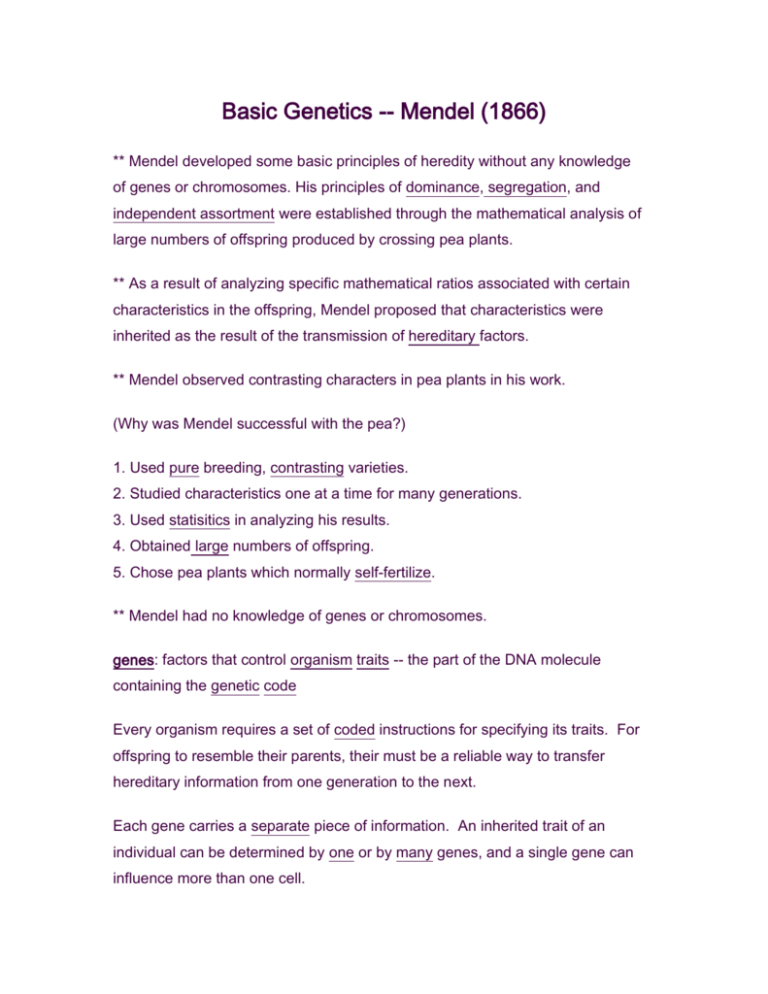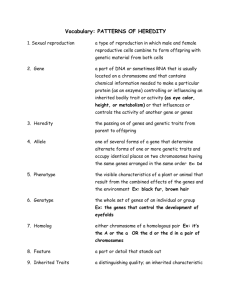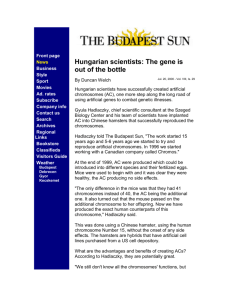Basic Genetics -
advertisement

Basic Genetics -- Mendel (1866) ** Mendel developed some basic principles of heredity without any knowledge of genes or chromosomes. His principles of dominance, segregation, and independent assortment were established through the mathematical analysis of large numbers of offspring produced by crossing pea plants. ** As a result of analyzing specific mathematical ratios associated with certain characteristics in the offspring, Mendel proposed that characteristics were inherited as the result of the transmission of hereditary factors. ** Mendel observed contrasting characters in pea plants in his work. (Why was Mendel successful with the pea?) 1. Used pure breeding, contrasting varieties. 2. Studied characteristics one at a time for many generations. 3. Used statisitics in analyzing his results. 4. Obtained large numbers of offspring. 5. Chose pea plants which normally self-fertilize. ** Mendel had no knowledge of genes or chromosomes. genes: factors that control organism traits -- the part of the DNA molecule containing the genetic code Every organism requires a set of coded instructions for specifying its traits. For offspring to resemble their parents, their must be a reliable way to transfer hereditary information from one generation to the next. Each gene carries a separate piece of information. An inherited trait of an individual can be determined by one or by many genes, and a single gene can influence more than one cell. Each human cell contains thousands of different genes. alleles: different forms of a gene associated with a particular characteristic (ex. height -- tallness -- shortness) chromosomes: hereditary units of an organism locus: particular point where a certain gene is found on a chromosome homologous chromosomes: pair of associated chromosomes -- each chromosome in the pair is called a homologue ** Alleles are located in the same position or locus on homologous chromosomes. In asexually reproducing organisms, all the genes come from a single parent. These genes are normally identical to the parent. (clone) Sexually reproducing organisms normally receive half their genetic information from the Mother's egg and half their genetic information from their Father's sperm. Sexually reproduced offspring resemble but are not identical to their parents. ** The significance of Mendel's work was not immediately recognized. ** Mendel's hereditary factors, now called genes, exist at definite loci in a linear fashion on chromosomes. Two genes associated with a specific characteristic are known as alleles and are located on homologous chromosomes. The gene-chromosome theory provides the mechanism to account for the hereditary patterns which Mendel observed. homozygous (pure) -- an individual with two of the same alleles on homologous chromosomes heterozygous: (hybrid) -- an individual with contrasting alleles for the same trait on homologous chromosomes parental generation (P) -- the two original organisms being crossed first filial generation -- the first generation of offspring from the parents second filial generation -- generation of offspring arising from the first filial generation Some Major Genetic Concepts 1. Law of Dominance (Mendel) a pattern of heredity in which only one gene of an allelic pair is expressed thus in the heterozygous condition, one allele of a gene may express itself and mask the presence of the other allele ex. red flowering X white flowering-->red flowering peas dominant trait: the trait or allele that is expressed recessive trait: the trait or allele that is present but that is not expressed progeny: offspring siblings: brothers or sisters Punnett square: used to represent genetic crosses genotype: the genetic makeup of an organism phenotype: the appearance of an organism 2. Principle of Segregation and Recombination (Mendel) -- When gametes are formed during meiosis there is a random segregation of homologous chromosomes. -- As a result of fertilization, alleles recombine. As a consequence, new allelic gene combinations are likely to be produced. ** Segregation and recombination is illustrated by the cross between two individuals heterozygous for a trait. 3. Law of Independent Assortment (Mendel) --If the genes for two different traits are located on different chromosomes (nonhomologous chromosomes), they segregate randomly during meiosis and, therefore, may be inherited independently of each other. The cross of two organisms heterozygous for a trait is known as a hybrid cross. ** Assuming large numbers of such crosses, the phenotypic ratio of dominant offspring to recessive offspring is 3:1 and the genotypic ratio of homozygous dominant offspring to heterozygous dominant offspring to homozygous recessive offspring is1:2:1 [Intermediate Inheritance] 2 examples -- incomplete dominance and co-dominance (a.) Incomplete Dominance -- A case of contrasting alleles in which one allele is only partially dominant over the other --the dominant allele is only partially expressed when the recessive allele is present. (Sometimes called blending inheritance) examples: red X white snapdragons ----> pink snapdragons This is also true in Japanese 4 o'clock flowers. ** A cross between long and round squashproducing oval offspring also illustrates this concept. (b.) Codominance: a case of contrasting alleles in which neither allele is dominant over the other (alleles have equal power) ex. cross between red and white short horned cattle gives roan cattle ex. cross between black and white Andulusian fowl gives blue (gray) fowl ** Examples of codominance in humans are the blood groups and the sickle cell trait. (sickle cell anemia) gene linkage: when genes for two different traits (nonallelic genes) are located on the same chromosome pair (homologous chromosomes) Linked genes are usually inherited together. crossing over: during synapsis in the first meiotic division, the chromatids in a homologous pair of chromosomes often twist around each other, break, exchange segments and rejoin. ** Crossing over results in the rearrangement of linked genes and increases the variability of offspring. Note in the picture above the four chromosomes make up a tetrad in synapsis. The second stage shows crossing over, and the last stage shows the genetic variability produced in the new gene combinations. karyotype: an enlarged photograph of the chromosomes in an organism Above is a karyotype of a normal human male. Human diploid cells contain 23 pairs of chromosomes. autosomes: body chromosomes (22 pr. in humans) Homo sapiens has one pair of sex chromosomes. ** In the male each sex chromosome is unlike and is designated XY. In the female each sex chromosome is alike and is designated XX. ** The sex of a human is genetically determined at fertilization when a sperm cell containing either an X or a Y chromosome unites with an egg cell containing an X chromosome. Mutations: changes in genetic material ** While an altered gene (mutation) may be passed on to every cell that develops from the mutated cell, only mutations in sex cells may be passed on to the offspring. ** A mutation occurring only in body cells may be perpetuated in the individual but will not be passed on to the offspring by sexual reproduction. -- Mutations may be classified as chromosomal alterations or gene mutations. -- The effects of chromosomal alterations are usually quite visible in the phenotype of the organism because many genes are usually involved. [Types of Chromosomal Alterations] 1. Nondisjunction: homologous chromosomes fail to separate during meiosis, producing offspring with one chromosome more or less than is normal disjunction -- the separation of homologous chromosomes during meiosis ** If disjunction fails to occur (nondisjunction), gametes with an addition or a missing chromosome will be produced. Polyploidy The presence of one or more entire additional sets of chromosomes in an organism (3n,4n number, etc.) Polyploidy is also caused by nondisjunction (But of an ENTIRE set of chromosomes.) Mutation: a random change in the chemical nature of the genetic material (DNA) Most mutations are harmful and recessive. While the effects of some gene mutations, such as albinism, are obvious, the effects of other gene mutations may not be as readily noticed. Mutagenic Agents -- increase the random incidence of mutations 1. Radiation -- X-rays, ultraviolet, radioactive substances, and cosmic rays 2. Chemicals -- formaldehyde, benzene, asbestos fibers, THC, nicotine ** The adaptive value of a gene mutation is dependent upon the nature of the mutation and the type of environment with which the organism interacts. ** The environment interacts with genes in the development and expression of inherited traits. (3 examples) 1. Many green plants contain chlorophyll for food making but if these leaves are screened from the light they stop making chlorophyll. 2. Identical twins raised in different environments may be vastly different in intelligence. 3. If some white fur is shaved from a Himalayan rabbit and the area is kept cold with an ice pack, black fur will grow back in its place. (The gene for black fur is active only at very low temperatures.) ** The principles of genetics appear to hold true for all organisms including humans. The acquisition of knowledge of human genetics has been limited because humans are not suitable subjects for experimentation. An increased knowledge of human genetics has resulted from the expansion of the field of genetic counseling. Types of Selective Breeding 1. Artificial Selection -- individuals with desirable traits are mated to produce offspring with those traits 2. Inbreeding -- offspring produced by artificial selection are mated with one another to reinforce those desirable traits 3. Hybridization -- crossing two individuals with different desirable traits to produce offspring with a combination of both desirable traits ex. English shorthorn cattle X Brahman cattle --->Santa Gertrudis cattle (good beef) (heat resistance) (good beef) (heat resistant) 4. Mutations may be preserved by vegetative propagation. (ex. seedless oranges) 5. Recombinant DNA (genetic engineering) --- new varieties of plants and animals can be created by manipulating the genetic instructions of these organisms to produce new characteristics [Changes in Chromosome Structure] 1. Translocation: transfer of one section of a chromosome to a nonhomologous chromosome 2. Addition: a portion of one chromosome is attached to another chromosome 3. Deletion: a portion of a chromosome is taken away from a chromosome 4. Inversion: a portion of a chromosome breaks off and then becomes reattached to the same chromosome in an inverted (upside down) fashion Knowledge of genetics is making possible new fields of health care. Mapping of genetic instructions in cells makes it possible to detect, and perhaps correct, defective genes that may lead to poor health. Substances from genetically engineered organisms may reduce the cost and side effects of replacing missing body chemicals.








